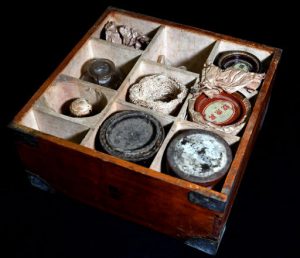Silent Witness: Medicine case used for first-aid activities contains bottle with intact antiseptic liquid
Mar. 23, 2020
by Miho Kuwajima, Staff Writer
Containing eight different kinds of medicine labeled, for example, “Tincture of iodine,” “Boric acid tablets,” and “Menthol,” as well as a scrubbing brush, a wooden case measuring 28 x 28 centimeters and 13 cm in depth is inscribed with the word “Taiichi” (Squad No. 1). The case was used by the Imperial Japanese Army as a first-aid kit for treating the injured at emergency relief centers after the atomic bombing. It includes a bottle with antiseptic solution still inside.
In September 1974, the late Kanichi Sanada, an Imperial Army soldier from the city of Fukuyama assigned to the Army’s Hiroshima Supply Depot, a unit responsible for supply of food and fuel, donated the medicine case and 50 kinds of medicine and medical equipment—all of which had been stored in a Taiikyu trunk (Army medical container)—to the Hiroshima Peace Memorial Museum, in Hiroshima’s Naka Ward.
Mr. Sanada was a sergeant major in the Army Medical Corps and experienced the atomic bombing while in the neighborhood of Yamaguchi-cho (now Kanayama-cho, in Naka Ward), where he was stationed. Severely injured after being trapped under a collapsed wooden house 1.2 kilometers from the hypocenter, he ultimately managed to escape. Mr. Sanada took with him two Taiikyu trunks from the Depot garage in the neighborhood and headed to the Fuchu-cho area to flee from the fires with a fellow soldier.
According to the record of an interview with Mr. Sanada conducted by a museum official, the two men stayed for a week at Fuchu National School (now Fuchu Elementary School), which was used as an emergency relief center, and engaged in providing first-aid to about 70 A-bomb victims with the medical supplies they had brought with them.
The Taiikyu trunk, in which was contained this medicine case, a canvas bucket, and a Red Cross flag, was displayed as part of a regular exhibit in the museum’s main building that ran through the spring of 2017, conveying information to visitors about rescue operations conducted immediately after the atomic bombing.
(Originally published on March 23, 2020)
Containing eight different kinds of medicine labeled, for example, “Tincture of iodine,” “Boric acid tablets,” and “Menthol,” as well as a scrubbing brush, a wooden case measuring 28 x 28 centimeters and 13 cm in depth is inscribed with the word “Taiichi” (Squad No. 1). The case was used by the Imperial Japanese Army as a first-aid kit for treating the injured at emergency relief centers after the atomic bombing. It includes a bottle with antiseptic solution still inside.
In September 1974, the late Kanichi Sanada, an Imperial Army soldier from the city of Fukuyama assigned to the Army’s Hiroshima Supply Depot, a unit responsible for supply of food and fuel, donated the medicine case and 50 kinds of medicine and medical equipment—all of which had been stored in a Taiikyu trunk (Army medical container)—to the Hiroshima Peace Memorial Museum, in Hiroshima’s Naka Ward.
Mr. Sanada was a sergeant major in the Army Medical Corps and experienced the atomic bombing while in the neighborhood of Yamaguchi-cho (now Kanayama-cho, in Naka Ward), where he was stationed. Severely injured after being trapped under a collapsed wooden house 1.2 kilometers from the hypocenter, he ultimately managed to escape. Mr. Sanada took with him two Taiikyu trunks from the Depot garage in the neighborhood and headed to the Fuchu-cho area to flee from the fires with a fellow soldier.
According to the record of an interview with Mr. Sanada conducted by a museum official, the two men stayed for a week at Fuchu National School (now Fuchu Elementary School), which was used as an emergency relief center, and engaged in providing first-aid to about 70 A-bomb victims with the medical supplies they had brought with them.
The Taiikyu trunk, in which was contained this medicine case, a canvas bucket, and a Red Cross flag, was displayed as part of a regular exhibit in the museum’s main building that ran through the spring of 2017, conveying information to visitors about rescue operations conducted immediately after the atomic bombing.
(Originally published on March 23, 2020)








